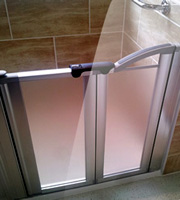Here’s Why Bathroom Accessibility Matters
An accessible bathroom improves mobility and safety especially for seniors and disabled persons. However, you need not be elderly or even disabled to worry about improving safety and functionality in the bathroom. In fact, here are 3 reasons why even young adult homeowners need to think carefully about improving the safety of their bathroom:
- Young Children: According to the Centers for Disease Control, over 80% of all falls in the home occur in the bathroom. With awkward balance and already prone to injuries, children can benefit from hand rails, taller toilets, and other features found in elderly or accessible bathrooms.
- Sudden Illness or Injury: It’s just a matter of time before a sudden illness or injury limits your mobility. Even simple and relatively common back injuries can make showers and tubs unsafe. An accessible bathroom helps reduce the risk of further injury to you in times of limited mobility.
- Extended Visits from Elderly In-Laws and Relatives: More and more families are living with multiple generations under one roof, and yes, this includes the grandparents! Having an elderly bathroom already in place reduces risk of injury for grandparents and grandchildren of like while giving you peace of mind.
Do You Have an Accessible Bathroom?
To quickly determine if your bathroom is accessible for seniors and anyone with mobility issues, ask yourself 5 simple questions:
- Do you have slippery tiles on your floor or tub/shower surface?
If the answer is yes, improve safety by placing non-slip mats outside the tub or shower area. Inside the shower or tub, install slip-proof flooring to provide extra traction and reduce injury risk.
- Do you have a short toilet?
If the answer is yes, then seniors or anyone with arthritis may have trouble getting down and up from the short toilet. To improve mobility, install a specially designed taller toilet and consider adding special rails for handicapped access.
- Do you have loose or insufficiently secured towel racks?
If the answer is yes, the towel racks need properly fastened but still will not make the room safe. For an accessible bathroom, consider installing new grip bars or special rails especially in and around the tower or tub area.
- Does your bathroom have sliding shower door(s)?

Sliding shower doors may be dangerous because they can move unexpectedly when you are trying to enter or leave the tub. To improve bathroom safety for the elderly, injured, and disabled, install a shower safety gate.
- Do you have a slip-resistant shower bench?
If the answer is no, consider getting one. A shower bench provides a resting area for the elderly or anyone with balance problems. For tubs, consider improving safety by installing a bath or transfer bench that allows the elderly and disabled to enter the tub without stepping over the sides.
Concluding Thoughts on Bathroom Safety for the Elderly, Injured, and Young Alike
You are more likely to be injured in the bathroom more than all the other rooms in your home combined. Even perfectly healthy adults can literally need the benefits of an accessible bathroom. Sudden injury, illness, children, or even in-laws staying for the weekend can create the sudden need for a safe bathroom area. Simple things like shower chairs, bath benches, slip-proof flooring, taller toilets, and grip bars can dramatically improve safety.
AccessableBathrooms specialise in elderly and disabled bathroom renovations to improve accessibility and safety for everyone that matters most in your life.
